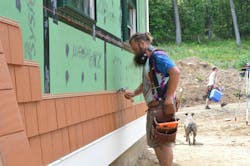With siding replacement, as with most home improvement jobs, it's common to face unexpected challenges after the old materials come down. Different companies have their own procedures for managing the unforeseen, but all aim for the same end: a homeowner relieved by the company’s professionalism and feeling great about the work—one who is more likely to remember your name when someone asks for a referral.
Manage Expectations Early
Veterans with years of siding jobs under the belt agree that because unanticipated situations are common and unavoidable, managing expectations is essential. It comes down to two things, says Jeff Petrucci, owner of Bloomfield Construction, in Bloomfield Hills, Mich.
The first is an estimate that accounts for all potential problems, rather than one that simply multiplies square footage by materials and labor to get a price. The second is alerting homeowners as soon as possible to evident trouble spots and the possibility of problems that might be found behind the wall.
“Change orders shouldn’t happen with siding, but they do,” Petrucci says, because “inexperienced people don’t do enough upfront discovery. They sell the job, and the crew goes out and tears something off and finds a layer of asbestos behind the aluminum, or rot behind the fascia, or the gutter falling off.”
Take A Thorough Look
Seasoned siding estimators start by not just measuring wall areas, but thoroughly examining the property itself. “We look at everything,” says Terry Stamman, of Twin Cities Siding Professionals. The St. Paul, Minn., company specializes in fiber cement siding, which installs on a flat surface and so requires walls to be stripped to sheathing on every job.
Four out of five times, Stamman says, there’s rot, so the company has added a page to its homeowner guide titled “The Four Stages of Rot,” which outlines how rot develops and what it costs, in time and materials, to fix.
Steven Jones, owner of Tulsa Renew in Tulsa, Okla., has another way of handling it: He won’t bring up the issue if it’s a small fix. “I don’t want to nickel and dime the client,” Jones says, “so I tell them I’m going to take care of it. If you’re worried about three hundred bucks on an average $30,000 project, then you’ve done a poor job selling it."
To find rotted wood or sheathing, Pat Quarve, owner of Quarve Contracting, in Spring Lake Park, Minn., starts by looking underneath the siding at the base of the house and around windows for evidence of water intrusion problems.
“We train our guys to identify those areas,” says Dan Merrifield, co-owner and vice president of sales for Lakeside Exteriors, a St. Louis-area contractor. Besides windows, another potential water intrusion trouble spot is any improperly flashed roof-to-wall connection. Photos of these should go right in with any bound proposal and eventual job folder, so everyone has documentation of preexisting issues.
Why Not Just Wait?
Some contractors or salespeople are reluctant to raise issues upfront because they often translate to an expanded scope of work and a higher, possibly noncompetitive contract price. But the benefits of being upfront with homeowners outweigh the risks. Most homeowners are okay with paying for additional work if they've been prepped for the possibility.
Scott Barr, owner of Southwest Exteriors in San Antonio, and others build a few extra labor hours into installation to minimize the need to consult clients for change orders, although sometimes it's unavoidable. Lakeside Exteriors, for instance, once stripped a wall around a deck only to discover that the band board, and what it was attached to, had rotted. It, along with the unmoored deck, needed to be replaced—a roughly $15K change order. Fortunately, Merrifield says, they had prepped the clients ahead of time on issues that they might find. “They knew a new deck was in their future," he adds. "Just not that day."
Hold a Pre-Con Meeting
Replacing windows or a roof typically takes a day or two, so preconstruction meetings for such projects are rare. But for many siding companies, who might spend two weeks on a jobsite, a pre-con conference is standard issue. “There’s just too much to be covered in the sales process and in the hand-off to production,” Barr explains.
Who attends the meeting, and what’s discussed, varies. Twin Cities Siding Professionals, for instance, brings the salesperson, the homeowner, and the production manager together on the property, usually 30 days before job start. That enables homeowners to sign off on every job detail, and the company to collect the deposit and order materials.
Other companies schedule their “pre-con” a week, or even a day, before start date. At Bloomfield Construction, the job superintendent walks the site with the salesperson. “He’s looking at it with a different set of eyes than the guy that sold it,” Petrucci says. The morning the job starts, the homeowner meets with the salesperson, production manager, and project superintendent.
Sticking to the Scope
Homeowners, he says, often have unrealistic ideas about what’s going to happen—that the great curb appeal of new siding will cure everything that’s wrong with the house. “They think that just because you’re putting on new siding, you’re going to fix their sagging porch,” Petrucci says. Make sure to explicitly discuss what you will be doing, and what isn't included in that.
About the Author

Jim Cory
Philadelphia-based writer Jim Cory is a senior contributing editor to Professional Remodeler who specializes in covering the remodeling and home improvement industry. Reach him at [email protected].
